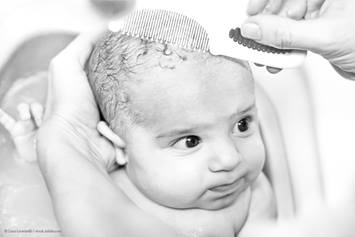Seborrheic Dermatitis (Cradle Cap)
Cradle cap is a common skin condition in babies. It looks like yellow or brown scales on the scalp. It’s not itchy or painful and usually goes away on its own. Parents can gently wash the baby’s scalp and use a soft brush to help remove the scales.
What Is Cradle Cap?
Seborrheic dermatitis (sebb oh REE ik der mah TY tis) is very common in infants and children. It appears as scaly, itchy, white, yellow or red patches. It most often appears on the scalp but can also be on the:
- Face
- Sides of the nose
- Eyebrows
- Ears
- Eyelids
It can appear in body folds and creases as bright red and shiny, including:
- Under the arms
- Elbow crease
- Behind the knees
- Neck folds
- Groin folds
Seborrheic dermatitis is often called cradle cap because it is common in infants. Cradle cap in infants usually improves between 8 and 12 months of age. It does not spread to others and probably does not bother your baby.
It also can happen during adolescence, which is called dandruff.
What Are the Symptoms of Cradle Cap?
Common signs of seborrheic dermatitis include:
- Patches of scaly skin or crusts on the scalp
- Greasy skin covered with flaky white or yellow scales
- Skin flakes or dandruff
- Mild to moderate redness.
What Causes Cradle Cap?
Seborrheic dermatitis is the result of an overgrowth of yeast on the skin. This combines with excess oil production and leads to redness and irritation on the skin. That causes the scaling and itching.
In infancy, this is often a result of the mother’s hormones in pregnancy or through breastfeeding. In adolescence, the hormones of puberty can lead to this condition.
How Is Cradle Cap Treated?
Treatments may include:
- Topical (on the skin) steroids
- Anti-fungal creams
- Medicated shampoos
Medicated shampoo should be used on the scalp and problem areas. It is left on for 5 to 10 minutes then washed out.
Cradle cap in infants usually clears on its own within a few months. During that time wash your baby’s hair or scalp once a day with mild baby shampoo. Home remedies listed below can help you control cradle cap.
- Gently rub your baby’s scalp with your fingers or a washcloth to loosen the crust.
- Wash his or her hair once a day with mild baby shampoo.
- If the patches do not loosen easily, rub petroleum jelly or a few drops of mineral oil on the scalp. Let it soak into the patches for a few minutes. Brush with a soft-bristled brush and shampoo the hair to get out the oil. If you leave the oil in your baby’s hair, the cradle cap may get worse.
- Once the scaly patches are gone, wash his hair every few days to prevent scaly buildup.
When to Call the Doctor
Call your child’s doctor if:
- The cradle cap does not go away after treating it at home
- The patches spread to your baby’s face or body
Other Information
- This condition may come and go in children. Use the medications when the rash is present.
- Sometimes the medicated shampoo is used weekly to prevent flaring. Ask your child’s doctor if this treatment should be continued after the rash is gone.
Helping Hands Patient Education Materials
Written and illustrated by medical, nursing and allied health professionals at Nationwide Children's Hospital, Helping Hand instructions are intended as a supplement to verbal instructions provided by a medical professional. The information is periodically reviewed and revised to reflect our current practice. However, Nationwide Children's Hospital is not responsible for any consequences resulting from the use or misuse of the information in the Helping Hands.
HH-I-323 | ©2011, revised 5/16, Nationwide Children’s Hospital



